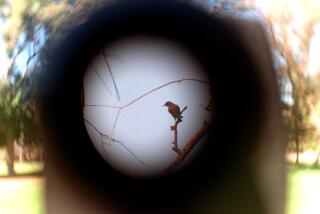The architects of aerial dreams
- Share via
One hundred years ago, quaint though the notion may seem today, science and technology were regarded as the expression of mankind’s highest goals and fondest dreams. The scope of the human race was expanding by quantum leaps and bounds. When Wilbur Wright was born, in 1867, there were no telephones, electric lamps, phonographs or wireless radios; sea travel from Europe to the distant lands of Asia was possible only via the Cape of Good Hope; the fastest ways for an individual to get around on land was by bicycle, trains and horses; and the tallest edifice in the world, at 481 feet, was the Great Pyramid of Cheops.
Then, on a blustery December day in 1903, on the sands of Kill Devil Hill, near Kitty Hawk, N.C., Wilbur and his brother Orville made the greatest leap of all when their fragile, ungainly brainchild, which they called “the whopper flying machine,” did what they asked it to do. As Orville later described it, in typically terse understatement, it was the first time “in the history of the world in which a machine carrying a man had raised itself by its own power into the air in full flight, had sailed forward without reduction of speed, and had finally landed at a point as high as that from which it started.”
Thus the fiercest intellectual sweepstakes of the young 20th century was won by a pair of dour bicycle makers in tight suits from Dayton, Ohio. Once the Wrights accomplished their breakthrough, the new technology hurtled into the future with dizzying speed. Six years after Kitty Hawk, Wilbur flew a Wright biplane around the Statue of Liberty, displaying the brothers’ absolute mastery of the air. Soon aviation firsts were being posted around the globe at an Olympic pace.
One of the most heroic of these early aerial exploits was Igor Sikorsky’s flight from St. Petersburg to Kiev, a distance of 750 miles, in 1914. Sikorsky, who later achieved fame in the United States as a designer and builder of helicopters, was a pioneer in the use of multi-engine, fixed-wing aircraft. Midway into his flight, one of the four inboard engines caught on fire, spraying a torch of flame on the right wing. Two of the crew walked out on the wing and put out the fire with their Russian greatcoats, and the plane safely landed in a field with the three remaining engines.
Sikorsky repaired the damaged engine and set off the next morning. Then, at 3,000 feet, the plane got caught in a storm and went into a spin that usually resulted in a deadly crash in the days before blind-flying instrumentation. Yet the resourceful aviator, after losing more than 1,000 feet in altitude, returned to controlled flight with only a magnetic compass to aid him.
Lightened by the expenditure of fuel, the craft obeyed its master, and the Russians soared above the clouds. Sikorsky put his copilot in charge, poured himself a cup of coffee and stepped out of the plane’s cabin to take in the view. “Our ship was gliding along a few hundred feet above a sparkling white surface,” he later wrote. “The air was calm and the plane seemed motionless with its huge yellow wings.... All around me there was a fairyland, formed by clouds.”
When Sikorsky landed in Kiev, the airfield was deserted; no one expected him to arrive in stormy weather. He was received by a lone dignitary, who told him the news: Austrian Archduke Franz Ferdinand had been assassinated in Sarajevo. The cloud fairyland was gone forever; the bravery of the early airmen would serve a different, darker cause.
Tales of the exploits of the Wrights, Sikorsky and their many competitors form the fascinating core of “Taking Flight,” a comprehensive history of the Aerial Age by Richard P. Hallion, a professor of aerospace history formerly associated with the U.S. Army War College and the Smithsonian Institution. Hallion’s command of his material is as breathtaking as the feats of the early jumpers, gliders and aviators he writes about, and his book is enlivened by an argosy of great stories and colorful, pithy quotes culled from a lifetime’s study.
Hallion is particularly good at reconstructing flight attempts from antiquity to the Middle Ages, including that of Eilmer, an 11th century monk at Malmesbury Abbey, England, who “by some contrivance fastened wings to his hands and feet, in order that, looking upon the fable as true, he might fly like Daedalus.” Thus equipped, Eilmer leaped into the air from the abbey’s highest tower, flew the distance of a furlong (approximately 600 feet) and fell to Earth, breaking both legs. Hallion visits Malmesbury, expertly re-imagines Eilmer’s brave jump within the scanty parameters of the information available and creates a vivid sense of the flying monk’s accomplishment.
Inevitably in a book of encyclopedic scope, not all the byways Hallion traverses will be fascinating to all readers. A few chapters end with a hurried recital of events in such far-flung places as Siam and Sweden. Knowing everything about a subject can be a liability: It doesn’t add much to our understanding of aviation to know that Thomas Selfridge, the first person to die in a flying accident, had an uncle who worked on the Panama Canal or that Edith Roosevelt, Theodore Roosevelt’s wife, and three of their children -- Archie, Ethel and Quentin -- attended an air show in France.
Paul Hoffman’s “Wings of Madness,” a biography of Alberto Santos-Dumont, the Brazilian aviation pioneer active in Europe in the early 20th century, is a model of lively, intelligent writing about popular science.
Hoffman, formerly the president of Encyclopaedia Britannica and editor-in-chief of Discover, introduces the reader to one of the most curious, charming figures of 20th century technology: Santos-Dumont, the scion of a coffee fortune, was the first man to fly an airplane in Europe, in 1906, with an oversized box kite attached to the front and a 24-horsepower engine.
The dapper, diminutive Brazilian had already been the toast of Paris for his exploits in lighter-than-air craft. In 1901 he won a prize for being the first to pilot a dirigible from the Aero-Club de Paris, in St. Cloud, around the Eiffel Tower and back; he divided the cash prize among his crew and the city’s poor. His most revolutionary invention may have been what he called the Little Runabout, a tiny dirigible small enough for cafe-hopping; he would moor the craft to lampposts, and waiters handed his drinks up to him.
Santos-Dumont’s fascinating life suggests that science was not only more idealistic a century ago; it was also more glamorous. Even his mishaps had a romantic charm. One of his many crashes tangled his airship in the boughs of a chestnut tree on the banks of the Seine; his impromptu host, Edmund de Rothschild, sent up a bottle of iced champagne. Then Rothschild’s neighbor, the Comtesse d’Eu, the daughter of Dom Pedro II, the fallen emperor of Brazil, sent the aviator a picnic lunch.
For all his aristocratic panache, Santos-Dumont made many solid contributions to aviation; it’s surprising he’s not better known outside Brazil, where he is still a national hero. In addition to his racing exploits, he designed the first mass-produced personal flying machine.
Hoffman writes: “Its fetching silk-covered wings gave it the translucent elegance of a dragonfly, which inspired the nickname Demoiselle (‘dragonfly’ or ‘young lady’). Demoiselle was the world’s first sport airplane.” Santos-Dumont believed that patents were immoral and made his designs freely available; soon hundreds of the little craft were flying French and American skies.
Hoffman’s research is thorough and impressive, and his presentation is stylish and well paced. The author’s frequent divagations are all entertaining (even if some strain their claim to relevancy); by book’s end, Hoffman’s reader has as firm a grasp of the essentials of early aviation as does Hallion’s. The book’s principal flaw comes at the end: Despite its sensational title, “Wings of Madness” deals only briefly with the mental illness that claimed its subject’s life, when Santos-Dumont committed suicide by hanging, in 1932, at 59. His last years in mental institutions are dispensed with in a few scant pages.
One would like to know more about the Brazilian’s final invention, for which he “glued feathers to his arms and strapped on wings powered by a small motor in a backpack”; a psychiatric nurse stopped him from jumping out a window. Nine hundred years after Eilmer’s leap from Malmesbury Abbey, the dream of flight still exerted a passionate hold on the human imagination.


